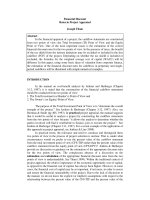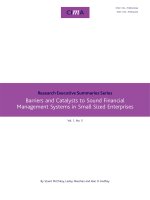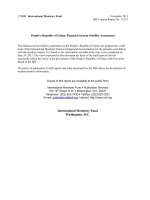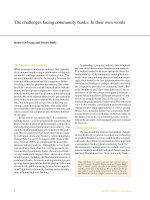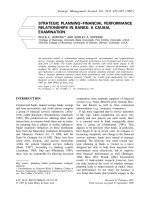Financial System Considerations in IFRS Conversion Projects doc
Bạn đang xem bản rút gọn của tài liệu. Xem và tải ngay bản đầy đủ của tài liệu tại đây (1.3 MB, 15 trang )
Financial System
Considerations
in IFRS Conversion Projects
1
1 Executive Summary
The purpose of this paper is to provide some brief
background about International Financial Reporting
Standards (IFRS) and provide awareness to the potential
impact to an organization’s financial systems when
completing an IFRS conversion project. The information
provided assumes the reader has some general
background information about IFRS. The following
information will be discussed throughout this paper:
Background of IFRS and Information Technology
(IT) impact when converting to IFRS
Key differences between IFRS and U.S. GAAP and
the impact to financial/business reporting
Implementation considerations
Learning from the European experience
IFRS transition in Canada
2 Background of IFRS & IT Impact
Today, more than 100 countries require/permit the use of
International Financial Reporting Standards (IFRS), or are
converging with the IASB’s standards. On February 24,
2010, SEC Chairman Mary L. Schapiro released a public
statement regarding convergence between International
Accounting Standards Board (IASB) and Financial
Accounting Standards Board (FASB) standards: “For nearly
30 years, the Commission has promoted a single set of
high-quality globally accepted accounting standards,
which would advance the dual goals of improving financial
reporting within the U.S. and reducing country-by-country
disparities in financial reporting, but supporting this goal is
only the beginning of the discussion, not the end.”
In the AICPA IFRS Preparedness Survey conducted in
September 2009, a 54% majority of CPAs believed
that the SEC should ultimately require adoption of
IFRS for U.S. public companies. Furthermore, more
than 50% of respondents expressed a need to know
some level of IFRS over the next three years. However,
with these uncertainties surrounding U.S. CPAs and
the SEC’s decision to mandate IFRS for U.S. public
companies, some organizations question, why convert
to IFRS? According to the IFRS Primer for Audit
Committees, considerations for filing of IFRS financial
statements include:
Multinational companies may benefit from the use
of common financial reporting systems
IFRS may ease financial statement comparability
among companies
IFRS is intended to facilitate cross-border invest-
ments and access to global capital markets
Other key benefits include opportunities to improve/
streamline business functions and processes, globally
integrate the financial IT systems, and achieve consolidation/
reporting efficiency. On the other hand, there are risks
associated when a company decides to convert to IFRS.
Some of these risks are excessive resource spending,
improper data management or migration, incomplete
revisions of policies and procedures, future changes that
standard setters may issue, and more.
While there are many benefits and risks to converting
to IFRS, a few key factors should be taken into
consideration prior to implementation or during project
planning. Although the IASB and FASB are working
toward convergence, many differences currently exist
between the two sets of standards (see Key Differences
between IFRS and GAAP below). It will be important to
monitor the changes as the two boards complete their
joint work plan as outlined in their Memorandum of
Understanding (MoU). Furthermore, companies should
first assess which principles/standards will impact their
organizations directly, conduct some research, and have
a strong understanding prior to implementation. A
detailed discussion regarding project planning is further
explored under Implementation Considerations.
2
Potential System Impacts of an IFRS
Conversion
As a company prepares to convert to IFRS, the impact to
information technology (IT) and financial systems should
be taken into consideration during the planning phase.
Representatives from the company’s IT department
should be involved throughout the planning process
to evaluate how the proposed accounting changes will
impact the financial systems (transactional or reporting).
The impact to IT and financial systems can vary
depending on a company’s existing structure and
environment. This may include its IT and financial systems
capability/integration, industry complexity, company size,
relevance of business process/transaction, internal control
structure, mergers & acquisitions process, and other
attributes.
If a company’s IT and financial systems are substantially
integrated globally, then the degree of impact or
modifications may be lower (although this is not always
the case). The extent of changes may be primarily some
sub-ledger configuration changes and more extensively
in the general ledger and consolidation system. However,
if a company has frequently acquired entities (each with
unique financial systems) and has not yet integrated
the acquired company systems within the organization’s
infrastructure, then the degree of system impact may be
quite large at the sub-ledger level as well as the internal
reporting level.
The extent of changes may also vary depending on
the consolidation method that management chooses.
Consolidations may be implemented at the corporate-level
or at each individual country/entity. However, companies
that implement at the corporate level may potentially run
the risk of error and potentially re-stating their financial
statements as well as other situations if the numerous journal
entry adjustments are not tracked or controlled properly.
Furthermore, if a dual reporting system is in place during
the transition period, the reconciliation process needs to be
taken into consideration. Reconciling between two different
“views” of the financial statements poses different problems
than singularly supporting one version or the other. Therefore,
having an effective reconciliation reporting system is an
important aspect to the learning curve of the IFRS transition.
While system changes will have costs associated with
them, some companies or the management team may
view the IFRS conversion project as an opportunity to
re-assess and improve the internal business processes. It
will be up to the organization to determine which path
to choose, and the outcome associated with the path.
Below is a chart that highlights some of the impact to IT
and financial systems.
If the company is ready to convert to IFRS, it’s important
to ensure that the company has good change
management policies and procedures in place. Having
strong policies and procedures will be beneficial if further
system revisions are required and traceable for internal
Type of System
Sub-ledger System General Ledger System Consolidation System
Internal Reporting System
Typical Impact
Configuration in
existing system
New or upgrade of
sub-ledger system
Alternative reporting
solution
Revision of chart of
accounts
Multiple set of GL
accounts (or “books”)
Extract, transform and
load (ETL) tools
Data quality management
Data warehousing
system/metadata
repositories
Business intelligence
system
Reporting queries/
programs
Examples
Conversion from LIFO
reporting
Tracking of R&D
expenditures
GAAP, IFRS and local
statutory reporting
Tax reporting
Segment reporting
Disclosure requirements
External reporting
requirements (examples)
listed in the left
Role of XBRL in facilitating
Possible change in entities
to be consolidated
Budget and forecasting
models
Revenue analysis reports
Exhibit 1
Potential System Impacts During IFRS Implementation
3
control purposes. Refer to Implementation Considerations
below for more details about impact to Internal Controls.
3 Key differences between
IFRS and GAAP
& impact to financial/
business reporting
Transaction Differences
There are a number of differences between U.S. GAAP
and IFRS. Below is a chart that highlights a few of these
differences.
In addition to the transaction examples listed below,
the IASB and FASB are also working jointly on several
MoU projects targeted for completion in 2010 and 2011.
Major convergence projects include:
Revenue Recognition
Leases
Financial Instruments
Consolidations
De-recognition
Fair Value Measurement
Financial Statement Presentation
Financial Instruments with Characteristics of Equity
As these major MoU projects are completed and new
standards are released by the FASB, these changes will
impact how the transactions are recorded, processed and/
or reported within a financial system (most likely prior to
converting to IFRS depending on the time of completion).
It is important to monitor both the FASB and IASB Web
sites for project updates on when the standards are under
exposure draft (review) and ready for release (final).
Certain IFRS/GAAP differences may be adjusted through
General Ledger journal entries or chart of account
structuring and do not require system changes at the
sub-ledger level. The approach will vary depending on
the organization’s structure and environment described
above in Potential System Impacts of an IFRS Conversion.
Additionally, this list of examples will continue to change
Accounting Transaction Primary Difference(s) Impact to IT Systems Examples/Applicability
Inventory IFRS does not permit Last In
First Out (LIFO) method
Method of measuring
inventory
Reversal of write-downs
Process and unit cost
calculation changes may
be required in inventory
sub-ledger system
Manufacturers, retailers,
distributors
Property, Plant & Equipment IFRS requires certain assets
and depreciation be recorded
at component level
PPE assets may be required
to account separately by
significant component pieces
Manufacturers
Intangible Assets (such as R&D)
and Impairment
Development costs may
be capitalized when certain
conditions are met and require
more detailed reporting
Impairment testing
System changes may be
required to capture R&D
projects’ costs in more detail
Manufacturers/high-tech
(e.g., software development)
Share-based Payments Timing of recognition
Valuation of liability-classified
transactions
Changes may be required in
the Payroll/HR/or alternative
sub-ledger system
Companies exchanging stock
or other equity instruments for
goods/services
Exhibit 2
Transaction Differences
4
as the FASB and IASB continue their efforts to converge
standards.
Impact to Financial or Business Reporting
Besides specific transactional differences, converting
from U.S. GAAP to IFRS will also impact a company’s
external and internal reporting requirements. Although
some transactional differences require only journal entry
adjustments within the General Ledger (or minimal
financial system changes), other changes may impact
an organization’s current reporting infrastructure (such
as data warehousing environment or associated report-
ing program). Furthermore, journal entry adjustments
for multiple countries and parallel reporting in IFRS and
GAAP may become cumbersome without additional
tools to assist in the reporting process (such as a con-
solidation tool). Below is a chart that highlights some of
these external and internal reporting examples.
Similar to the transaction differences, it is important to
monitor both the FASB and IASB Web sites for MoU-
related project updates since several of these projects
also relate to the financial reporting requirements listed
above. In addition, the challenge to implementing these
transactional or reporting changes is that organizations
will still have to consider dual reporting once the entity
decides to convert to IFRS. Companies will have to either
(1) maintain both processes for statutory reporting until
the three-year requirement is complete or (2) maintain
one process and make topside adjustments to the other
statutory reporting requirement. While both alternatives
are achievable, option 2 can become cumbersome, dif-
Reporting/Presentation Example of Difference(s) Impact to IT Systems Examples/Scenarios
Segment reporting Basis of segmentation
Segment reporting disclosures
required may differ
Additional categorization may
be required in the GL
Secondary segment may
need to be defined within the
reporting system
Segmentation defined may
differ due to Internal reporting
structure and business risks
associated
Interim reporting IFRS requires discrete
period approach
Data capture may need to
be revised to capture the
information properly
Costs that do not meet
definition of an asset cannot
be deferred
Financial Statement
Presentation and Disclosures
Presentation of comprehensive
income
Consolidation of subsidiaries
GL chart of accounts may need
to be re-mapped to present
dual reporting
Data capture may need to
be revised for a reporting or
consolidation system
Dual chart of accounts/general
ledger
Adjustment of financial
statements: balance sheet,
income statement & cash ow
Internal Business Reporting Potentially impact an
organization’s current reporting
infrastructure
Data structure may need
to be revised within a data
warehousing environment
Data capture may need to
be revised within a business
intelligence/reporting software
Supply chain dashboard/KPI
that reports from inventory
sub-ledger system
Calculation to determine
operational budget or product/
segment analysis
Exhibit 3
External and Internal Reporting Differences
5
ficult to track and not ideal/feasible. Explanation of the
dual-reporting timeline is further discussed under Imple-
mentation Considerations.
The AICPA’s IFRS Primer for Audit Committees addressed
two relevant IT-related questions that management
should consider during the implementation process:
How will this affect the company’s way of doing
business (e.g., changes to IT and other internal
systems; risk monitoring and controls; inventory
accounting; budgeting and forecasting; key per-
formance indicators; joint ventures and alliances;
subsidiaries; etc.)?
How is management making system changes or
implementing new systems today, in recognition of
possible changes in the future?
As the previous examples point out, transactional and
reporting differences between IFRS and U.S. GAAP do
affect a company’s way of doing business. This leads to
implementation issues to consider as a company decides
to convert to IFRS.
4 Implementation considerations
As with any major corporate initiative, planning ahead
is critically important. Sizing the task at hand allows for
prudent assignment of resources within the company
and engaging external assistance. Recognition and
indeed sponsorship by top management will help to
ensure the success of an IFRS implementation.
Project cost considerations
The cost of an IFRS implementation will be determined
largely by the size and complexity of the respective com-
pany. The SEC predicted that the largest U.S. registrants
that adopt IFRS early would incur about $32 million per
company in additional costs for their first IFRS-prepared an-
nual reports. This includes both internal and external costs.
Since the costs to convert can be substantial, the up-
front planning and project sizing are very important. The
6
estimates by the SEC are clearly averages and may not
correlate closely with individual company experiences.
It is evident that the time leading up to the conversion
will absorb the vast majority of budgeted dollars.
If managed strategically, the implementation could
be leveraged to accomplish other needed reporting
enhancements previously delayed. When viewed over
a longer horizon, an IFRS project could also accelerate
system improvements that were only on “wish lists” for
possible future consideration.
The extent of IFRS conversion
In evaluating and planning for an IFRS conversion, it is
not always clear at the outset where that “conversion”
will take place. The following summarizes some options
plus implications for IT.
a. Consolidated financial statements
In some companies, top-level-only adjustments
may be required to convert to IFRS. This may
be accomplished in existing consolidation tools
and/or may require supporting calculations for
the adjustments. While this may suggest that the
impact on IT would be minimal, it could never-
theless be necessary for underlying systems to
generate the data/information to make the top-
level adjustments. Tools such as Convergence
Assistant (discussed later) may be of help here as
companies make adjustments to convert to IFRS.
b. Separate financial statements (e.g.,
subsidiary level)
In an international company operating under
various jurisdictional requirements, it may be ap-
propriate for changes connected with IFRS to be
made at a subsidiary level. This means, of course,
that the underlying transactional detail must be
compiled at the subsidiary level. The subsidiary
systems may or may not be able to capture such
detailed information, which means that system
enhancements must be made at that level.
c. In parallel within the ERP system
Some ERP systems have the capability for run-
ning parallel “sets of accounts,” for example,
under U.S. GAAP and IFRS. This may assist
companies having such systems to plan for and
successfully convert to IFRS. IT challenges can
still remain under such systems.
Decisions must be made as to the appropriate
treatment of transactions so that information
feeding into the parallel accounts is appropriate.
Further, depending on the accounting issue,
information may need to be generated/
understood at a deeper level such as in the
payable or receivable systems. In other words,
the underlying systems of record may need to be
altered to accommodate a “new way of looking
at things” (IFRS).
d. Allow for the possibility of various
“versions” of IFRS
Although great efforts are being made to arrive
at a singular IFRS that cuts across all global
jurisdictions, there is the distinct possibility that
companies may face different versions of IFRS.
For example, there could be IFRS issued by
the IASB, adjustments under European Union
regulations, localized versions of IFRS, and so
on. IT systems can play an important role in
facilitating reporting under such varied scenarios
if the systems can render data and information
at a granular enough level to be rolled up in
different ways. Unless a company’s IT systems
allow for such uidity, workarounds may need to
be developed.
7
IFRS Adoption Timeline
Year -3 Year -2 Year -1 Year 1 Year 2 Year 3
PLAN DESIGN IMPLEMENTATION & ADOPTION
One possible solution to handling reporting
expectations could be the use of XBRL as further
discussed below in the section IFRS Transition
in Canada: How XBRL Is Helping. A key feature
of the XBRL Global Ledger (GL) Framework and
tools such as Convergence Assistant is that they
can facilitate reporting under different standards
such as U.S. GAAP and IFRS in parallel. XBRL GL
can also represent granular business information
in parallel such as maturity information, deprecia-
tion and many more items.
As companies begin to plan for the conversion project, the
project team should be aware that the conversion project
will involve multiple years of planning, design and imple-
mentation. This is assuming that two years of dual report-
ing will be mandated or required before the set adoption
date. A sample project line summary is presented below.
Internal Control considerations
Compliance with Sarbanes-Oxley requirements and meet-
ing external auditor expectations requires a company to
have a documented process of how financial reports are
completed. Depending on the extent to which processes
will change, be created, or run in parallel in an IFRS imple-
mentation, internal controls will need to keep pace. Con-
sequently, internal audit departments must be involved
from the beginning of an IFRS implementation and risks
and controls identified with any process changes.
The process of creating financial reports under IFRS not
only includes different ways of compiling data but also
involves judgments as to what that data means. In other
words, internal control systems/documentation may
need to be expanded to reect the increased use of
judgments and textual descriptions associated with IFRS.
Exhibit 4
AICPA’s Suggested Timeline Chart
Work Streams: Accounting & Reporting, IT Systems & Processes, Tax Compliance & Planning, Business & Organizational,
HR & Training, Risks & Controls, Project Mgmt & Communication
Impact
Assessment
Project Teams
Awareness &
Knowledge
Implementation
Strategy
Data Requirements
IT Systems & Controls
IFRS Accounting Policies
Business & Tax Issues
Communication, Implement Tax Strategies,
Modify Contracts & Agreements
Dual GAAP / IFRS Reporting
Adoption
Date Dec 31
Opening Balance
Sheet Jan 1
(Go Live)
8
As an example, IFRS requires certain assets and
depreciation be recorded at component levels and
consequently, processes will need to be upgraded to
capture this more granular data, and judgments must
be documented related to identifying components and
determining depreciation lives.
Training considerations
As suggested by the first arrow in the above timeline in
Exhibit 4, “Awareness and Knowledge” must be gained
early in the process. Such training can be obtained
either outside the company or through courses available
on the internal learning management system. Significant
to note is that the need for training extends beyond
the accounting department. Anyone who is moderately
involved in the IFRS conversion should have some basic
understanding of what is driving the need and system
upgrades.
Following the initial burst of training, companies will
need to develop an ongoing program that keeps staff
current on IFRS developments and fast-tracks new hires
into this new knowledge arena. Most accountants in
the U.S. will have had little or no previous educational
background with IFRS. Organizations such as the AICPA
have committed to being an excellent resource to the
entire financial community on IFRS subjects.
5 Learning from the
European Experience
IFRS conversions have been completed in numerous
countries and it can be instructive to consider those
experiences. The European experience can offer such
lessons. One cannot say that the “European experience”
was consistent across all involved countries but some
general insights can be gained.
The conversion from national GAAP reporting to IFRS
was first mandated by the Council of the European
Union in 2002 for all member states. Many of those
conversions occurred beginning in 2005 and additional
countries later became subject to the same requirement.
European companies generally had only about two years
to convert to IFRS. Many companies approached the
change from an accounting and reporting perspective
and dealt with business and operational issues later in
the process. While meeting the short-term requirements,
companies sometimes experienced longer-term
9
inefficiencies attributable to incomplete planning
or insufficient up-front investment in processes and
systems.
Some lessons learned from the European experience
include the following:
Start the planning process early. Most readers
understand that technology projects often require
long lead times. The average IFRS conversion time
is likely to be between two-and-one-half and three
years.
Identify difficult accounting or systems issues early
in the process. It would be a mistake to leave such
items to the tail end of a planning or implementa-
tion process. Researching and securing the judg-
ment of professionals on technical issues usually
takes time.
Allow for unforeseen problems as you near imple-
mentation. Systems should be tested well ahead of
the time to “go live.”
When evaluating accounting/reporting issues, give
due consideration to long-term impacts of the result-
ing decisions.
Devote extra attention to the extensive disclosure
changes that may be required by the conver-
sion. Such footnote information may need to be
gleaned (or created) from various internal sources
and systems. Consequently, when planning IT infra-
structure needs, envision how required information
will roll up to the financial statements.
Complete training early and often. Though some
groups within a company may be “experts” on
IFRS, there is a need to extend that understanding
beyond a small group. As described above in this
paper, changes are often required at transactional
or country-specific levels during a conversion to
IFRS. Having trained people at different levels and
locations will make for a smoother conversion and
also will provide a broader talent pool as people
transfer or advance within the company.
It should be noted that the costs to convert to IFRS will
likely be higher on a per company basis in the United
States than they were in Europe. Several factors are
at play here. The SEC requires two years of historical
comparative financial statements. Also, moving from a
“rules-based” U.S. GAAP to more “principles-based”
IFRS may be more onerous compared to some European
companies who were operating under national GAAP
more akin to principles-based standards.
6 IFRS Transition in Canada:
How XBRL Is Helping
Requirements
In Canada, publicly accountable profit-oriented enter-
prises will be required to use IFRS in interim and annual
financial statements on or after January 1, 2011. The
same Canadian entities that are facing the IFRS switch-
over in 2011 are currently exploring the use of the
Extensible Business Reporting Language (XBRL) within a
voluntary filing program (VFP) launched by the Canadian
Securities Administration (CSA). The VFP is based on the
local GAAP taxonomy (CA-GAAP) and IFRS.
This situation suggests that, on one hand, the Canadian
business community is facing a transition similar to the
one that the U.S. business community experienced with
the SEC XBRL VFP, now a mandate. On the other hand,
they are also facing the certainty of a relatively near
switch-over to a different set of accounting principles.
This creates two requirements for the business
community to adhere to: adoption of a new reporting-
oriented technology (XBRL) and transition to a new set
of accounting principles in regulatory reporting (IFRS).
While the transition to IFRS may impact a magnitude of
systems as described in Exhibit 1, this particular case
study example will primarily focus on the consolidation
and reporting aspects of the IFRS conversion project at
10
the trial balance level and during the phase of meeting
dual-reporting requirements (or parallel reporting in IFRS
and Canadian GAAP).
Why XBRL
XBRL provides two key features to support the transition
to IFRS:
Financial Reporting (FR) XBRL taxonomies provide
an existing authoritative, standardized and freely
available framework to support both CA-GAAP and
IFRS
The XBRL Global Ledger taxonomy (XBRL GL)
enables a distinctive standard-based approach that
captures differences in accounting principles at trial
balance or transactional level and reect them in
the resulting financial statements
The Convergence Assistant
XBRL Canada, the local Jurisdiction of XBRL Interna-
tional Inc., has worked with Canadian regulators, ac-
counting firms, and the XBRL team of the IASB in various
initiatives designed to support the Canadian business
community in the transition. Among these initiatives is
the development of the Convergence Assistant (CA) —
convergenceassistant.com — an XBRL-based, publicly
and freely available tool to help support both the transi-
tion to IFRS and the implementation of XBRL for regula-
tory filings.
The CA allows the user to upload a trial balance and to
map its chart of accounts to a standard chart of accounts
to generate the “views” of the resulting financial
statements under both the IFRS and the CA-GAAP
principles, leveraging predefined mappings — also
expressed in a standardized XBRL format — to the IFRS
and CA-GAAP XBRL taxonomies.
It is important to note that the CA is meant to help
companies understand how standards-based tools —
and XBRL in particular — can support the process of
IFRS transition, not intended to provide a complete
solution. In this example, only trial balance information
is considered; this means that differences between the
two sets of accounting principles that are not captured
at trial balance level are not supported.
This example can help users understand the concept
of standardizing metadata and use it as a foundation to
implement within their own corporate environment to
provide the level of completeness required. However,
it is possible to apply the same standardized approach
to information “below” the trial balance level – at
transactional level, where many of the differences that
are not immediately available in a simple account to
account mapping are captured. It is also possible to
standardize and incorporate in the same way non-
transactional information that is also required for a
complete set of financial statements. The more the user
broadens the scope of standardization and inclusion of
different types of data, the more the end result will be
complete and final.
On the other end, there is value also in not going all
the way. Standardize only a part of the process where
the benefits of standardization of data from different
data sources/business units/processes are particularly
significant, and integrate the additional information
required in other ways in a separate step. The value of
a standards-based approach is that it does not replace
(necessarily) existing processes and applications; it helps
integrate data and make retrieving/reporting the data
more efficient.
11
Process Overview
Reporting structural differences between local GAAPs
and IFRS are often, even though not exclusively, reect-
ed at trial balance level — See Exhibit 5 for an example
A standard chart of accounts (SCOA) with pre-
defined mappings to IFRS and local GAAP financial
reporting concepts can distinguish these differ-
ences and make them available in an application-
independent environment — meaning that they
can be applied to corporate data no matter in what
accounting software or ERP application that data
was created or is stored — and immediately
applicable to the business’ specific data with a
simple account-to-account mapping
Other differences can be reected at more granu-
lar level — journals, transactions — that can also
be standardized and linked in a similar way
A relevant part of the IFRS/Local GAAP gap analy-
sis can be captured using XBRL GL, the Canadian
GAAP, and IFRS XBRL taxonomies
Software applications based on standards such as
XBRL help companies transition from local standards to
IFRS more easily. While all the functionalities that the
Convergence Assistant does can easily be achieved
by a proprietary-based application developed for the
purpose, utilizing a standards-based application has
additional benefits; the Convergence Assistant and the
artifacts that it generates can tailor to the user’s specific
requirements, integrate in their existing processes and
IT infrastructure without the need to modify them in any
way, and cross-support other key internal reporting and
auditing processes.
Exhibit 5
An example of reconciliation between different financial reporting standards at trial balance level
The example in Exhibit 5 is limited to differences that are captured at trial balance level, but it demonstrates how the availability
of a sufficient level of detail underlying the financial statements (or metadata attributes) enables the representation of
relationship between reporting concepts in the two formats that cannot be expressed in a direct mapping between the concepts
themselves. The same approach can be applied to information that is captured below the trial balance level, for example at the
transactional level, or in separate data sources, which can also be standardized and linked using XBRL GL.
Current Assets
Cash and cash equivlalents 20,199 19,778
Receivables 18,490 16,292
Inventories - LIFO 25,364 23,242
Prepaid expenses and other
current expenses
8,955 7,137
Deferred income tax 85 60
73,093 66,509
Assets, Current
Inventories - FIFO 31,364 30,242
Trade and other receivables 18,490 16,292
Finance lease receivables 198 188
Other financial assets 8.757 6,949
Current tax assets 85 60
Other assets - -
Cash and bank balances 20,199 19,778
79,093 73,509
Financial statements – US GAAP
Financial statements – IFRS
Income Statement
Cost of goods sold 286,000 257,000
Income Statement
Cost of sales 280,000 243,000
Account Description Amount D/C Date
1210 Materials 24,435 D 6/30/2008
1220 Work in process 929 D 6/30/2008
1350 Inventory Adj. 6,000 D 6/30/2008
Total 31,364
12
Conclusion to Transition In Canada
The Canadian experience shows how a standards-based
IT approach can not only provide an effective solution for
the immediate need of transitioning to IFRS, but can also
do so in an application-independent environment. The
fact that corporate data are seldom, if ever, available in a
single data repository/software package — even when a
consolidation/reporting application is in place — is a
major issue that makes the reporting and transition
process even more challenging.
A standards-based approach successfully addresses this
process issue by providing a single, standardized “view”
on the relevant data no matter where they were created
or are currently stored, via mapping. Once the data is
standardized, a single, consistent set of conversion rules
supported by an open standard and centrally maintained
can be applied to it. This enables/supports the transition
process; compliance with an XBRL regulatory mandate
— if existing — is also achieved along the way.
Such a solution becomes a sort of standardized browser
that allows leveraging the intellectual property on the
internal knowledge of local GAAP/IFRS convergence or
transition and make it transparently available through
the mappings to enable the automated comparison
and reconciliation between the financial statements
expressed under the two sets of accounting principles.
In a broader perspective this approach enables a more
sustainable processing environment that can effectively
automate current compliance processes that are largely
manual, decentralized and redundant, especially in
global entities that have to comply with different
jurisdictional requirements.
Even though not in scope in the Canadian application,
the extensibility of XBRL taxonomies and the possibility
to support additional reports that share the same
underlying data are represented by XBRL taxonomies,
either publicly available or developed internally. This
provides opportunities for businesses to build on this
standards-based data integration, reconciliation and
convergence approach to support other key processes
like internal reporting — business intelligence, tax
compliance, management reporting — or internal
auditing and controls. Another key consideration in this
respect is that the implementation of this approach does
not require the replacement of the existing systems;
rather, it complements them by providing incremental
functionalities that would otherwise require a substantial
investment in the corporate IT environment.
The next IFRS IT resource will be issued late 2010 to provide a deeper dive of IT-related topics not discussed in this paper such as:
infrastructure, data governance and data repositories, configuration changes, report design requirements and many more.
13
References:
iasb.org
sec.gov
xbrl.org
aicpa.org
ifrs.com
aicpa.org/infotech
fasb.org
AICPA IFRS Readiness Tracking Survey – 09/2009
International Financial Reporting Standards (IFRS) — An
AICPA Backgrounder
IFRS Primer for Audit Committees
“Are You Ready for IFRS? Moving Beyond the Basics”,
Volume I, Leah Donti, AICPA Publication, 2009 and
Volume II, Deloitte Touche Tohmatsu, AICPA Publication,
2009
“IFRS Accounting Trends & Techniques”
, Patricia Doran
Walters, AICPA Publication, 2009
Contributing Authors:
Gianluca Garbellotto is an internationally acknowledged
expert on the business and technical aspects of the
Extensible Business Reporting Language (XBRL) and XBRL
Global Ledger Framework (XBRL GL). He is the current
Chair of the XBRL Global Ledger Working Group, a
member of the IMA XBRL Advisory Group and the XBRL
columnist for IMA’s Strategic Finance magazine.
Janis W. Parthun, CPA/CITP, CISA is a senior technical
manager of the AICPA’s IT Section and Certified
Information Technology Professional (CITP) Credential
program. The focus of the IT Section and CITP
Credential program is to provide educational resources
to CPA professionals interested in Information Assurance
and Information Management.
Greg Zegarowski, CPA is the president of the Financial
Leadership Corporation, a company focusing on
building sustainable success through enhanced
reporting, compliance, and data governance. He is
currently a voting member of the international XBRL
Global Ledger Working Group and a frequent speaker at
professional events.
Copyright © 2010 American Institute of CPAs
T: 888.777.7077 | F: 800.362.5066 | E: | W: aicpa.org/infotech
10414-378
